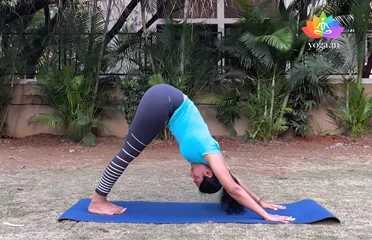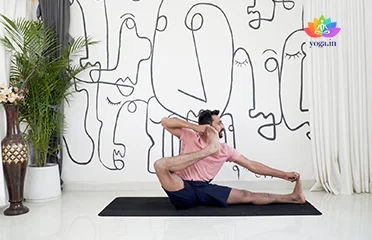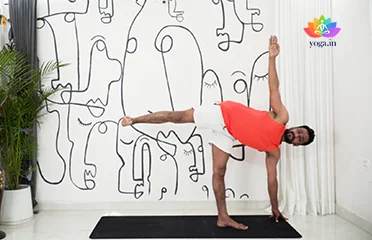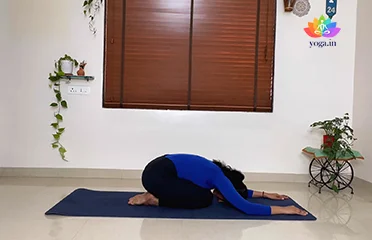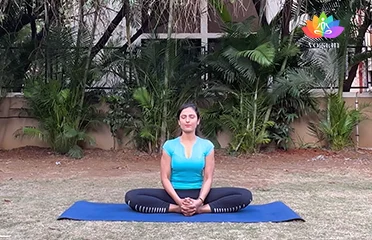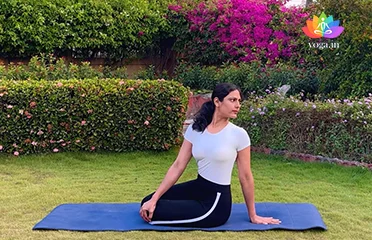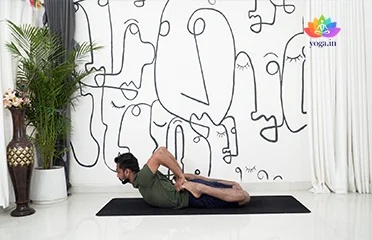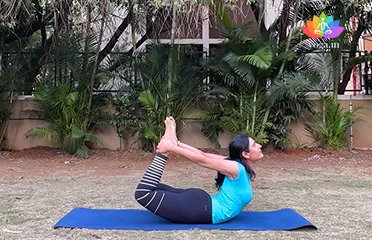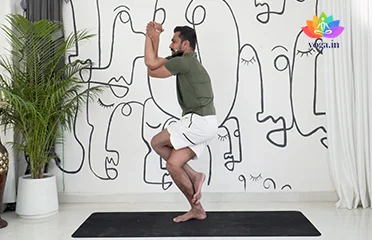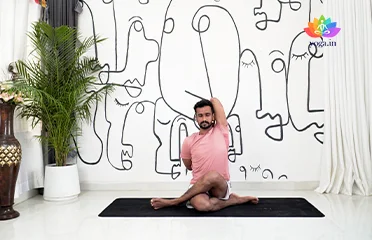Adho Mukha Svanasana (Downward-Facing Do
अधोमुख श्वानासन / Downward-Facing Dog Pose
The sanskrit name is derived from adhas (अधस्) meaning down, mukha [�K]
Akarna Dhanurasana (Archer Pose)
अकर्णा धनुरासन / Archer Pose
The Sanskrit name is derived from Akarna (अकर्णा ) meaning towards [�K]
Ardha Chandrasana (Half Moon Pose)
अर्धचन्द्रासना / Half Moon Pose
The Sanskrit name is derived from Ardha (अर्ध) meaning half, Chandra [�K]
Balasana (Child’s Pose)
बालासना / Child's Pose
The Sanskrit name is derived from Bala (बाला) meaning child and āsana [�K]
Bhadrasana (Gracious Pose | Butterfly Po
भद्रासन / Gracious Pose | Butterfly Pose
The Sanskrit name is derived from Bhadra (भद्रा) meaning gracious, [�K]
Bharadvajasana (Seated Spinal Twist)
भरद्वाजसन / Seated Spinal Twist
The Sanskrit name is derived from Bhardvaja (भरद्वाज) means bringing [�K]
Bhekasana (Frog Pose II)
भेकासन / Frog Pose II
The Sanskrit name is derived from Bheka (भेका) meaning frog and asana [�K]
Dhanurasana (Bow Pose)
धनुरासन / Bow Pose
The Sanskrit name is derived from Dhanur (धनुर) means bow and Asana [�K]
Garudasana (Eagle Pose)
गरुडासन / Eagle Pose
The Sanskrit name is derived from Garuda (गरुडा) meaning eagle and [�K]
Gomukhasana (Cow Face Pose)
गोमुखासन / Cow Face Pose
The Sanskrit name is derived from Gau (गो) meaning cow, Mukh meaning face [�K]
- 1
- 2
- 3
Finding Relief – Yoga for Ankles
Ankles are complex joints that bear significant weight and enable a wide range of movement. They’re crucial for activities like walking, running, and jumping. Unfortunately, ankle pain and stiffness are common issues that can limit mobility and quality of life.
Key Factors Contributing to Ankle Problems:
- Sprains: Rolling or twisting your ankle can stretch or tear ligaments, leading to pain, swelling, and instability.
- Arthritis: Degenerative changes in the ankle joint can cause pain, stiffness, and reduced flexibility.
- Tendinitis: Inflammation of the tendons surrounding the ankle joint can cause pain and tenderness.
- Muscle strains: Overuse or improper technique can lead to muscle strain in the calves, ankles, or feet.
- Improper footwear: Shoes that lack adequate support or don’t fit well can contribute to ankle problems.
- Balance issues: Weak core muscles or inner-ear problems can affect balance and increase the risk of ankle sprains.
Symptoms of Ankle Issues:
- Pain: This can range from a dull ache to sharp pain, and may worsen with activity.
- Swelling: Inflammation can cause the ankle to appear puffy or swollen.
- Stiffness: Difficulty moving the ankle freely, especially in the morning or after sitting for long periods.
- Instability: A feeling of weakness or giving way in the ankle joint.
- Bruising: Discoloration of the skin around the ankle joint after an injury.
- Redness: Inflammation may cause the skin around the ankle to appear red and warm.
Treatment of Ankle Problems:
Treatment for ankle problems depends on the underlying cause and severity. It may involve:
- Rest: Limiting activities that aggravate the pain is crucial for healing.
- Ice: Applying ice packs to the affected area can reduce inflammation and pain.
- Compression: Wrapping the ankle with a compression bandage can help minimize swelling.
- Elevation: Keeping the ankle elevated above the heart can promote healing.
- Pain medication: Over-the-counter pain relievers can help manage pain and inflammation.
- Physical therapy: Exercises to improve flexibility, strength, and balance can aid recovery and prevent future injuries.
- Ankle brace: In some cases, wearing a brace can provide support and stability for the ankle joint.
- Surgery: In severe cases, surgery may be necessary to repair ligament tears or fractures.
Yoga and Pranayama for Ankle Health:
While not a cure, yoga and pranayama can be valuable tools for managing ankle issues by:
- Improving Flexibility: Gentle yoga stretches can increase the range of motion in the ankle joint, making daily activities easier.
- Strengthening Muscles: Specific yoga poses can target muscles around the ankle joint, improving stability and support.
- Balance Training: Yoga poses that challenge balance can help improve proprioception (body awareness) in the ankles, reducing the risk of sprains.
- Pain Management: Yoga’s focus on deep breathing and relaxation can help manage pain associated with ankle issues.
Caution:
- Listen to Your Body: Always prioritize comfort and avoid poses that cause pain. Modify poses as needed and don’t push your limits.
- Start Slowly: Begin with gentle stretches and gradually progress to more challenging poses.
- Warm-up: Prepare your body with light movement before practicing yoga.
Contraindications:
- Acute Sprains: Avoid yoga until the initial inflammation and pain subside.
- Severe Arthritis: Consult your doctor before practicing yoga to ensure it’s safe for your specific condition.
- Balance Issues: If you have significant balance problems, practicing yoga with a supportive wall or partner is advisable.
- Unhealed Fractures: Weight-bearing yoga poses should be avoided until a fracture has fully healed.


